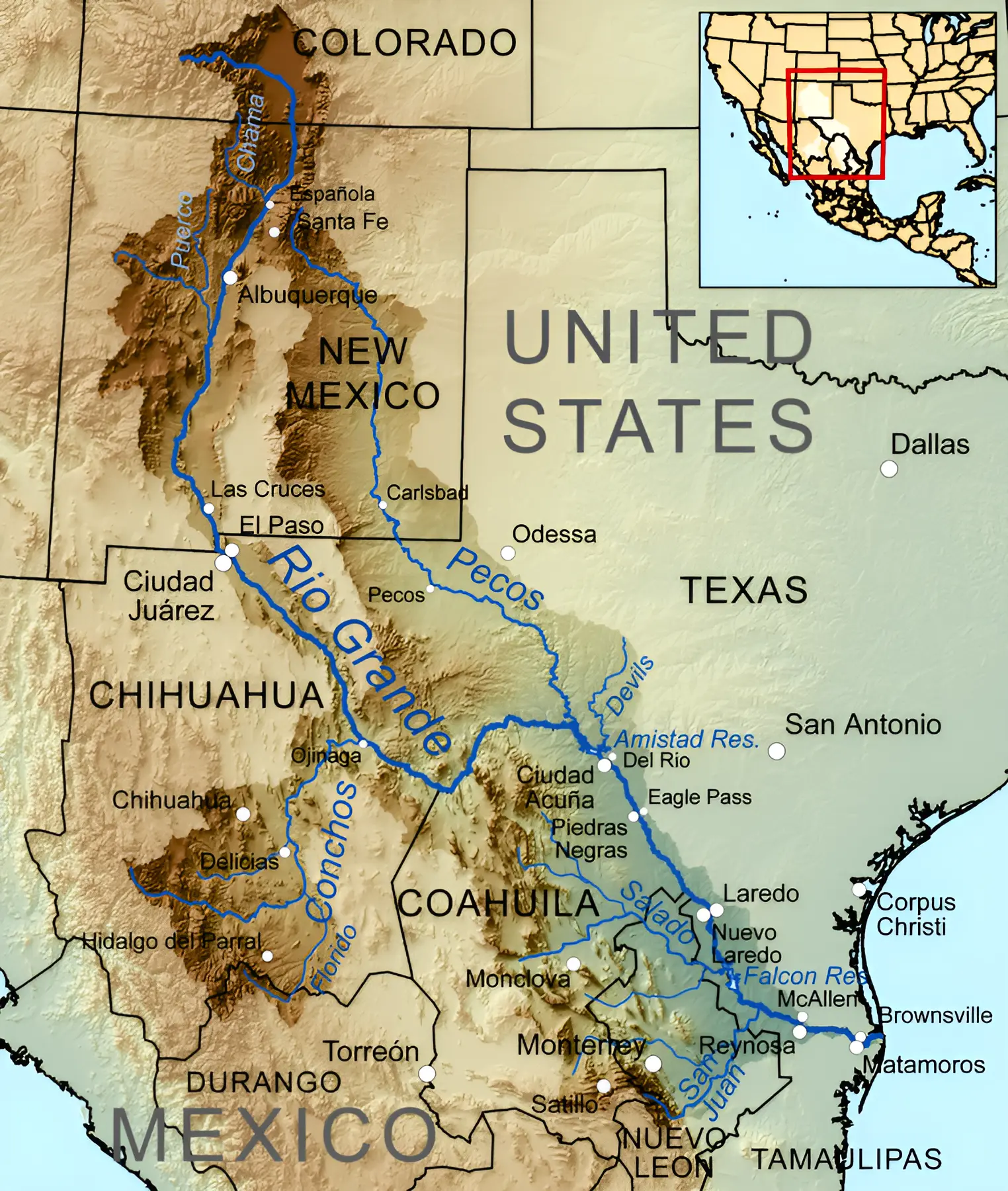The Annual Report, Conducted by American Rivers, classed the Rio Grande River as America’s ‘most endangered river.
| An endangered river is a river system that has shown the potential to wholly or partially dry up, or has exhibited ecological issues that may affect its flow in the near future. |
|---|
Endangered Rivers: The Rio Grande, along with the San Juan, Gila, and Pecos rivers flowing through the US state of New Mexico, is endangered due to the loss of clean water protections.
Hotspot of Migration: In recent years, the Rio Grande has become a hotspot of migration into the US from the rest of the Americas as well as around the world.

The Rio Grande river is one of the longest rivers in North America, running around 1,900 miles (3,060 kilometres) from the Colorado Rockies southeast to the Gulf of Mexico.
| Must Read | |
| NCERT Notes For UPSC | UPSC Daily Current Affairs |
| UPSC Blogs | UPSC Daily Editorials |
| Daily Current Affairs Quiz | Daily Main Answer Writing |
| UPSC Mains Previous Year Papers | UPSC Test Series 2024 |
The Finance Ministry notified amended rules under the Foreign Exchange Management Act to allow up to 100 percent Foreign Direct Investment (FDI) for the Indian space sector through three categories of liberalised entry routes.
100% FDI for Manufacturing, Operation of Satellites: 100 per cent FDI has been allowed for the Indian space sector category of manufacturing and operation of satellites, satellite data products, and ground segment and user segment.
Foreign Exchange Management Act (FEMA):
|
|---|
49% FDI for Launch Vehicles: Automatic FDI has also been permitted up to 49 per cent for launch vehicles and associated systems or subsystems and the creation of spaceports for launching and receiving Spacecraft.
Enabling Power Indian Space Sector: Currently, ISRO operates spaceports in the country. By allowing 49 per cent FDI in the segment, the government aims to make the ecosystem more enabling for private companies.
Increasing share in Global Space Economy: Indian space sector’s share of the global space economy is between 2 and 3 percent.
Indian National Space, Promotion and Authorization Centre (INSPACe)
Functions:
|
|---|
| Must Read | |
| NCERT Notes For UPSC | UPSC Daily Current Affairs |
| UPSC Blogs | UPSC Daily Editorials |
| Daily Current Affairs Quiz | Daily Main Answer Writing |
| UPSC Mains Previous Year Papers | UPSC Test Series 2024 |
US officials have warned that North Korea has been developing ‘poison pens’ and sprays as a part of their biological weapon (BW) programme.
CRISPR:
|
|---|
Geneva Protocol (1925): It banned the use of asphyxiating, poisonous, or other gases, usually referred to as chemical weapons, as well as the use of bacteriological methods of warfare.
Biological Weapons Convention (1975): It is also known as Convention on the Prohibition of the Development, Production and Stockpiling of Bacteriological (Biological) and Toxin Weapons and their Destruction.
| Must Read | |
| NCERT Notes For UPSC | UPSC Daily Current Affairs |
| UPSC Blogs | UPSC Daily Editorials |
| Daily Current Affairs Quiz | Daily Main Answer Writing |
| UPSC Mains Previous Year Papers | UPSC Test Series 2024 |
Recently, the Bihar government took an initiative to promote the Kesariya Stupa, as a major tourist attraction worldwide.
The Kesariya Stupa is a significant Buddhist monument. It is also a pilgrimage site for Buddhists worldwide.

About Stupa:
|
|---|
Eight smaller replicas of famous tourist attractions will encircle the Kesariya Stupa. These tourist points are the Mahabodhi Temple, ancient Nalanda and Vikramshila universities, Ashokan Pillar of Vaishali, Vikramshila University, Barabar Caves, Sujata Stupa, Gurpa Hills Buddhist site, and the Vishva Shanti Stupa.
| Must Read | |
| NCERT Notes For UPSC | UPSC Daily Current Affairs |
| UPSC Blogs | UPSC Daily Editorials |
| Daily Current Affairs Quiz | Daily Main Answer Writing |
| UPSC Mains Previous Year Papers | UPSC Test Series 2024 |
The Defence Research and Development Organisation (DRDO) conducted a successful flight test of a long-range Nirbhay cruise missile also known as Indigenous Technology Cruise Missile (ITCM) from the Integrated Test Range (ITR) in Chandipur off the coast of Odisha.

The Nirbhay cruise missile demonstrated very low altitude sea-skimming flight and followed the intended route using waypoint navigation.
Defence Research and Development Organisation (DRDO)The DRDO is the premier R&D agency under the Department of Defence Research and Development in the Ministry of Defence, Government of India.
|
|---|
Development: The Nirbhay Cruise Missile is developed by Bengaluru-based DRDO laboratory Aeronautical Development Establishment (ADE) along with contributions from other laboratories and domestic industries.
Missile Specifications: The two-stage ICTM is six-metre long and weighs around 1.5 tonne. It can cruise at a speed of 0.9 Mach and strike targets at up to 1,000 km.
Significance: This successful flight test has established the reliable performance of the indigenous propulsion system developed by Gas Turbine Research Establishment (GTRE), Bengaluru.
| Must Read | |
| NCERT Notes For UPSC | UPSC Daily Current Affairs |
| UPSC Blogs | UPSC Daily Editorials |
| Daily Current Affairs Quiz | Daily Main Answer Writing |
| UPSC Mains Previous Year Papers | UPSC Test Series 2024 |
The Indian economy has faced significant challenges due to a lack of acceleration in private investment.
Stagnant Growth of GFCF: This is indicated by the stagnant growth of private Gross Fixed Capital Formation (GFCF) as a percentage of gross domestic product (GDP) at current prices.
| Gross Domestic Product (GDP):
It is the market value of all the goods and services produced within a country’s domestic territory during a specified period, usually one year. |
|---|
Decline in Private Investment: Private investment in India has steadily declined since 2011-12. In 2019, the government reduced corporate taxes from 30% to 22% to encourage private investment.
Significance of Private Investment: Private investors are often regarded as more efficient capital allocators than public officials as it avoid wasteful spending.
Gross Fixed Capital Formation (GFCF) refers to the growth in the size of fixed capital in an economy. Fixed capital refers to assets like buildings and machinery that require investment to be created.
Trend of Private Investment: In India, private investment began to increase after the economic reforms of the late-1980s and the, early-1990s that improved private sector confidence.
Trend of Public investment: Public investment as a percentage of GDP increased steadily from less than 3% of GDP in 1950-51 to overtake private investment as a percentage of GDP in the early 1980s.
Pre and Post-Global Financial Crisis: The increase in private investment persisted until the global financial crisis of 2007-08, surging from approximately 10% of GDP in the 1980s to around 27% by 2007-08.
Low Private Consumption Expenditure: The failure of private investment to pick up over the last decade has been attributed to low private consumption expenditure.
Structural Issues: Unfavourable government policy and policy uncertainty may likely be the reason behind fall in private investment as a percentage of GDP over the last decade or so.
Inverse Relationship: Historically, there has been no direct correlation between an increase in private consumption and a rise in private investment in India. In fact, a decrease in consumption spending has often boosted private investment rather than suppressing it.
Private final consumption expenditure (PFCE):
|
|---|
Reasons for Inverse Relationship: It may be likely because the money that is allocated towards savings and investment, either by the government or by private businesses, comes at the cost of lower consumption expenditure.
| Must Read | |
| NCERT Notes For UPSC | UPSC Daily Current Affairs |
| UPSC Blogs | UPSC Daily Editorials |
| Daily Current Affairs Quiz | Daily Main Answer Writing |
| UPSC Mains Previous Year Papers | UPSC Test Series 2024 |
According to the recent reports of the United Nations Population Fund (UNFPA), India’s population is estimated to have reached 1.44 billion, with 24 percent in the 0-14 age bracket.
About UNFPA:
|
Under the new terminology by the World Health Organization(WHO), airborne viruses will be called “pathogens that transmit through the air”.
World Health Organisation (WHO):
|
About Airborne Viruses and Disease:
Examples of Airborne Diseases:
|
As per the latest data from the Global Forest Watch monitoring project, India has lost 2.33 million hectares of tree cover since 2000, equivalent to a 6% decrease in tree cover.
About Tree Cover Loss (TCL):
About Primary forests:
About the Food and Agriculture Organization (FAO):
|
About Global Forest Watch (GFW):
|
Recently, a report has been published by the Bretton Woods Committee’s Multilateral Reform Working Group (MRWG) on strengthening the Bretton Woods Institutions in order to address the 21st-century global challenges.
Global Commons: These include various cross border challenges that do not fall within national jurisdictions.
|
Multilateralism:
|
The Bridgetown Initiative:
|
| Existence of Gaps | Public Sector | Private Sector |
| Governance |
|
|
| Implementation |
|
|
| Accountability |
|
|
About Bretton Woods System:
About Bretton Woods Committee’s Multilateral Reform Working Group (MRWG):
|
Recently, the Allahabad High Court has observed that UP ‘Anti-Conversion’ law prohibits live-In relation between interfaith.
About Uttar Pradesh’s Prohibition of Unlawful Conversion of Religion Act, 2021:
|
Factors Responsible for Religious Conversion in India:
|
Anti-Conversion Laws in Various States:
|
Freedom of Religion in the Constitution of India:
|
Supreme Court Judgements Regarding Anti-Conversion Laws:
|
<div class="new-fform">
</div>
